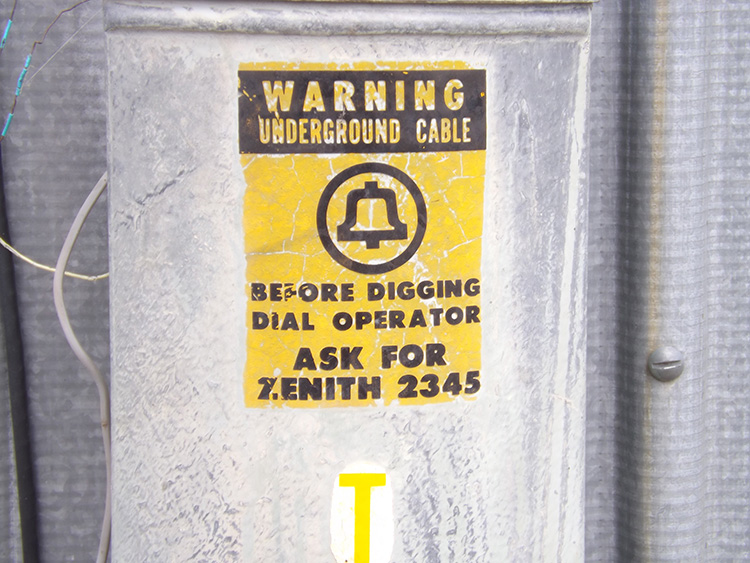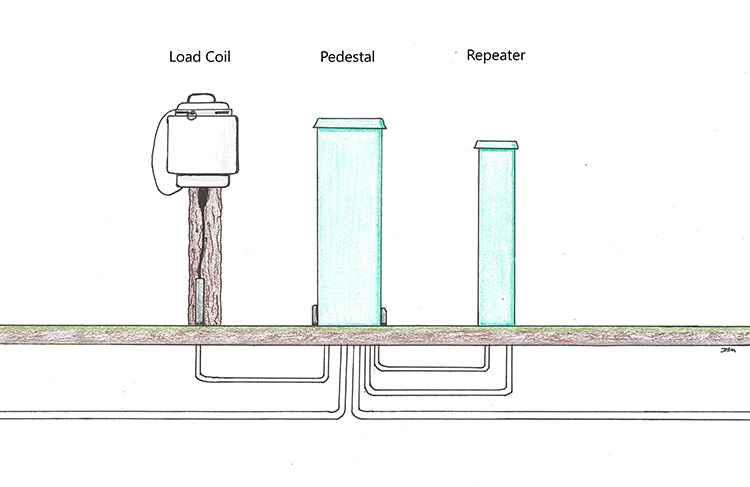RURAL SERVICE WIRE
A farm house in the 1920’s with a single telephone service was not a big money maker. It could take years to recoup the cost of placing service wire to the farm house in the first place and any break in the service would mean a costly repair that could add several more years to the break even date.
The 1934 Communications Act mandated phone service for every home in America. It not only required phone companies to supply service to farm houses if it was requested, it also offered financial rewards to them to do it.
The invention of rural service wire was a very simple invention, a single pair phone service with a rigid outer jacket, and copper-clad steel conductors instead of full copper conductors. As these wires were single pair side by side rather than twisted wires it was much cheaper to produce and it could hold up to severe weather conditions better than the standard service wires. Called Rural Service Wires or RSW, they are also commonly called BSW for Buried Service Wire or ASW for Aerial Service Wire. Another common acronym is CRW whose meaning is a little obscure but probably stood for Communication Rural Wire. Whichever name is used, they all imply a single pair phone service of usually rigid material that will run for a long distance in a rural area. Because of their length, Rural Service Wires are the only telephone service that will usually be indicated on phone prints.
Rural Service Wires are also quite often used for tracer wire for fiber optic cable, and used as interconnects in traffic system.
TELEPHONE TERMINOLOGY
AP (ACCESS PEDESTAL)
Many of the larger telephone pedestals are for cable splices only. They usually do not have any phone services inside, just cables. They are also usually constructed in a 3 piece format, a top and 2 sides. This allows good access to the cables since the entire above ground structure can be easily removed, and is responsible for a common term of access pedestal or AP in many areas. They are also commonly known as a splice box or splice cabinet.
CO (CENTRAL OFFICE)
The term “central office” was coined by Alexander Graham Bell himself. It was meant as a rather vague description of a building where all of the phone lines in a particular region came to a central connection.
In a large metropolitan area a CO is usually an office building with numerous employee offices, and a connecting vault. The vault may very well be more of an underground complex. They can be multi-storied structures with literally hundreds of copper and fiber cables. Above ground the CO area may seem to be just the office building, but underneath the parking lot, the landscape, and the even the street, there can be a massive vault two or more stories high, with it’s own lighting system and air conditioning.
In a rural area a CO may be a building no larger than a shed, and with as few as three or four cables total. Other CO’s will fall somewhere in the middle. They may be about the size of a convenience store with two or three employees working inside, and a couple of standard size manholes out front. Typically all CO’s, whether large or small, are brick buildings.
COPPER
Telco technicians often use the word “copper” when referring to any telephone cable (lead, paper, or PIC cables) because they all have copper conductors in the tip and ring wires. So, it is common to hear phone techs refer to cables as either fiber or copper.
CROSS-CONNECT aka CROSS-BOX aka X-BOX aka SAI
A large phone enclosure that contains a series of terminal boards. The enclosure has actual doors that open instead of a lift-up cover like a phone pedestal. This is the cross over point between manholes and the above ground phone enclosures (AP’s and pedestals). All phone cables from the CO to the cross-box are considered feeder cables. From the Cross-box to the building, they are distribution cables. Cross connects are technically known as SAIs, for Service Area Interface.
DIRECT BURIED CABLE
Any cable that is not in a conduit or duct run is a direct buried cable.
DUCT RUNS
Duct runs make up the main transmission portion of a phone cable plant. The Telcos refer to these main runs as feeder lines, not transmission lines.
ENCAPS
Encaps can denote a number of different things. The one thing they have in common is an encapsulated splice. This is any phone splice where the connections of tip and ring wires are completely sealed. Many phone pedestals have encapsulated splices, but there are also small round flush-mounted phone pedestals that are commonly called encapsulated pedestals. In this case, the entire cable is left below ground, and the encapsulated splice includes the connections to the service wires, and only the service wires come up into the round pedestal. Encapsulated pedestals were only placed in some small areas, mainly in the 1980’s.
LOAD COIL
A small metal coil which is attached to a single telephone cable, then connects into a 3-way splice in a cable run. Load coils provide an even current in the telephone cable run. They are extremely necessary and common throughout a POTS telephone cable plant. They can be seen attached to short poles next to telephone pedestals, inside telephone cabinets, pole lines, and even inside manholes. They are often labeled with the abbreviation LC on the load coil housing, and often on phone prints.
In most parts of the country load coils are above ground in a separate enclosure. In a few regions load coils are buried directly under the phone pedestals. In this situation, the cable extending downward to the load coil will have a white striped mark on it.












































